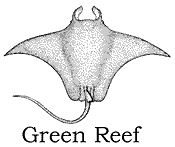 |  |  |
 | |
 | |
 Ambergris Caye Coral Reef Monitoring:
Ambergris Caye Coral Reef Monitoring:Shallow Back Reef and Patch Reef Habitats
Introduction
Ambergris Caye is located along the Belize Barrier Reef, the second longest barrier reef in the world. The proximity of this reef system to the community of San Pedro provides residents and visitors an opportunity to visit and enjoy this superb natural resource. However along with the economic benefits derived from a tourism-related dive industry, comes a reliance on the health status of the coral reef ecosystem. The reef system of Ambergris Caye has, during the last decade been subject to several events which may have reduced the health of the reef. The reefs of Belize suffered severe coral bleaching events in 1995 and 1998 (McField, 2001; Aronson et al., 2000). Several areas of the reef have also been subject to high incidences of diseases including black band disease, white band disease, and white plaque. Two large hurricanes have also hit the area during the last decade, Hurricane Mitch in 1998 and Hurricane Keith in 2000. Continued and consistent monitoring of the Barrier Reef should occur to quantify and record the incidences and effects of these events. Indeed several programs in Belize are monitoring the deeper fore reef areas but little to no work has been done in the shallow water patch and back reef systems near Ambergris Caye. These areas are especially susceptible to changes in water temperatures from global climate change and also physical damage from tourism related activities.Project Objectives and Intended Results
This project will gather baseline data which will serve to quantify percent coral cover and incidents of diseases and coral bleaching at areas that have previously only have been anecdotally documented.This will provide for the initial data set in what is anticipated to be an ongoing monitoring program. It will also be able to make quantitative comparisons between areas that are designated as MPA'a and those that have not been afforded any special legal protective status. These data will be used to make comparative observations both of the environmental characteristics of the particular sites and also in relation to the relative threats due to development activities facing each site. Data and conclusions drawn from this survey will be shared with the staff at Bacalar Chico National Park and Marine Reserve and the Belize Fisheries Department, the Coastal Zone Management Authority and Institute (which is currently conducting coral reef monitoring in other locations). Additionally conclusions drawn from this year's monitoring will be shared with the conservations community in Belize by dissemination through BACONGO (Belize Alliance of Conservation Non-Governmental Organizations), of which Green Reef is a member and with the general population of San Pedro through publications in local newspapers. By publicizing and sharing this information it is hoped that this project will be able to continue as a long-term monitoring plan. Green Reef is a founding member of BEMEMCCOR (Belize-Mexico Alliance for the Management of Common Coastal Resources) and coral reef monitoring has been outlined as a project priority for this organization. It is hoped that this project can be integrated as a part of a larger scale monitoring program that would encompass the entire Meso-American Barrier Reef System.
Description of Project Activities
Monitoring will take place at six sites in the vicinity of Ambergris Caye during May and June of this year(2001).Three patch reefs and three back reef habitats will be surveyed using the point line intercept transect method. In addition to the transects, which will provide percent coral cover values, disease and mortality will be monitored using the bar drop method and abundance counts of Diadema antillarium will be conducted along each of the transects. Ten, 10-m transects will be conducted at each of the six sites which include the patch reefs at Mitchell Rocks, Mexico Rocks, and Rocky Points. Additionally the back reefs near the cuts at Caye Chapel, Mexico Rocks and Rocky Point will also be surveyed. Field work is expected to take approximately ten days to complete and data analysis and report compilation another additional ten days| Mooring Buoys | Nassau Grouper Research and Advocacy Program | Jewfish Monitoring | Coral Monitoring |
| Bird Sanctuary | Advocacy | Environmental Education | Public Awareness | Indigenous Plant Nursery |
100 Coconut Drive, San Pedro Town, Ambergris Caye, Belize Phone: +501-226-3254 ext 243 |
Legal & Legislation | Reef Briefs | Notice Board | Membership | Gift Shop | Links
Funders and Sponsors | Volunteer | News
